Friction Point
“The point where the friction created between the clutch plates begins to propel the motorcycle forward”
Why do we need a Clutch?
In simple terms, a clutch is the mechanical connection between the motorcycle’s engine and its transmission. With the motorcycle in first gear and the clutch fully engaged, the bike’s speed would typically be far too fast to perform the required slow-speed skills.
We must learn how to use the friction point in such a way that subtle clutch engagement and disengagement allow the rider precise control at low speeds.
It’s worth noting that anyone can ride a motorcycle fast. On our course, fast riding is often a sign that a rider isn’t yet comfortable with balance or with the friction point. When our students ride slowly, with eyes up and in full control of the clutch, we know we’ve done our job as instructors.
A Simplified Mechanical Discussion
Motorcycle clutches differ slightly from automobile clutches in design.
The clutch pack consists of a Clutch Basket, which is typically connected to the engine (and spinning when the engine is running), and an Inner Hub, which connects to the transmission (and doesn’t spin when the motorcycle is stationary). These two components spin independently from one another.
Inside the clutch pack are alternating Friction Discs, which key into the Clutch Basket, and Steel Discs, which key into the Inner Hub. The picture below shows how these connect.
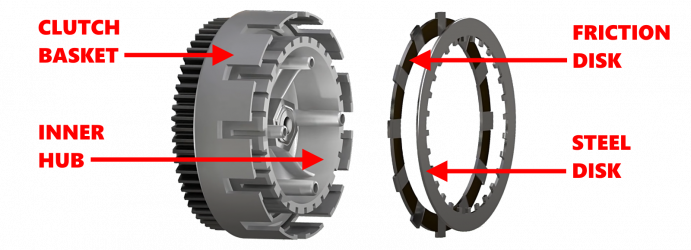
A Pressure Plate sandwiches the multiple friction and alternating steel discs together using powerful Clutch Springs, effectively binding them into what’s called a Clutch Pack.
When the rider pulls in the clutch lever with the left hand, the mechanism — either mechanical or hydraulic — overcomes the pressure created by the clutch springs. This reduces friction between the discs, which in turn reduces the power sent to the transmission.
Unlike automobile clutches, most motorcycle clutches are bathed in engine oil (wet clutches), making them better suited to handle the heat created by friction. We often see students who have experience with manual-transmission cars struggle at first because they’ve learned not to “ride the clutch.” Motorcycles are designed differently — they expect you to “ride” the clutch a little at low speeds. (Yes, there are a few motorcycles with dry clutches, but they’re quite rare.)
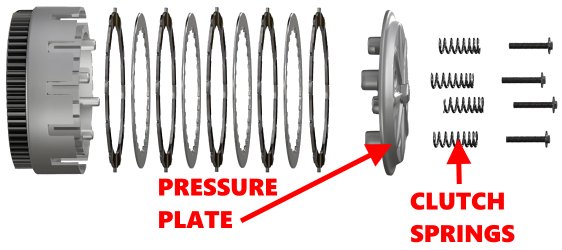
Understanding Clutch Lever Positions
To simplify things, imagine the clutch lever (operated by the rider’s left hand) as having five positions.
Position #5 – Stop
This is when the lever is fully pulled into the handlebar (see the picture below). If you ever get into trouble while riding, your muscle memory should automatically pull in the clutch lever and roll off the throttle. Doing so removes all power from the transmission. Essentially, at this point, you’re coasting — just like a pedal-less bicycle.
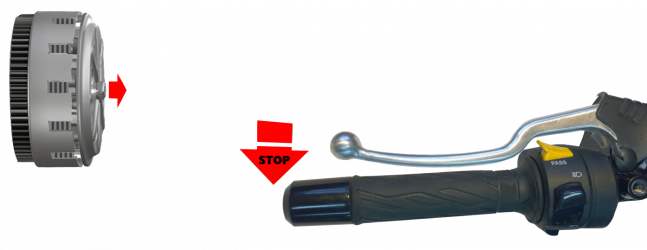
Position #1 – Go
This is the fully released position. Here, the engine is 100% connected to the transmission by those powerful clutch springs. A motorcycle traveling down the road in 2nd, 3rd, or higher gear — and not shifting — would typically have the clutch lever in the #1 position.
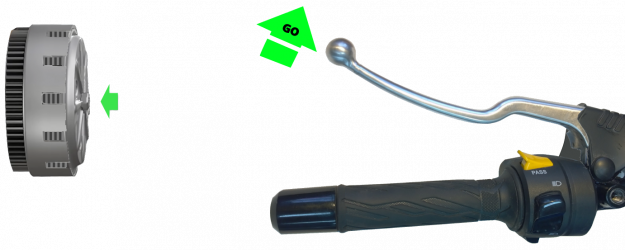
Position #3 The Friction Point (Friction Zone)
The friction point, sometimes called the friction zone, corresponds roughly to position #3 on the clutch lever.
“The point where the friction created between the clutch plates (friction and steel) begins to propel the motorcycle forward.”
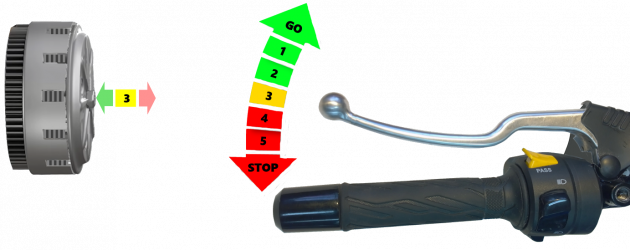
When riding at slow speeds in first gear, a rider should always find and ride within the friction zone — around that #3 position.
Gently move from #3 toward #4 when you want to reduce power, and from #3 toward #2 when you need to add power. This technique allows you to stay smooth on the motorcycle and always have power available when needed.
Just remember: during slow-speed riding, the clutch lever isn’t a light switch — it’s not simply “on” or “off.” Smooth, controlled adjustments are key.
Developing the Feel
There’s absolutely no need to look down at your clutch lever while riding — this skill is all about feel. Once mastered, it becomes second nature and will stay with you for your entire riding life. Even the most experienced riders perform a quick “friction point test” before each ride, especially when they’re on an unfamiliar motorcycle.
